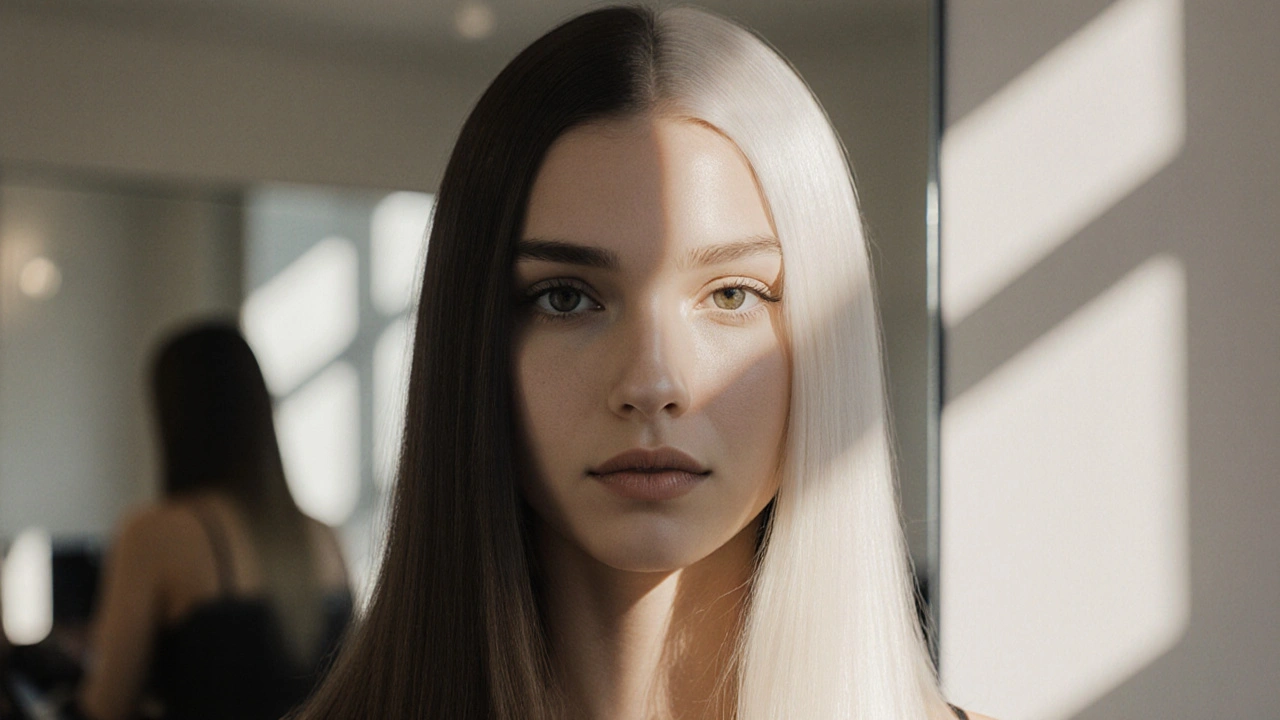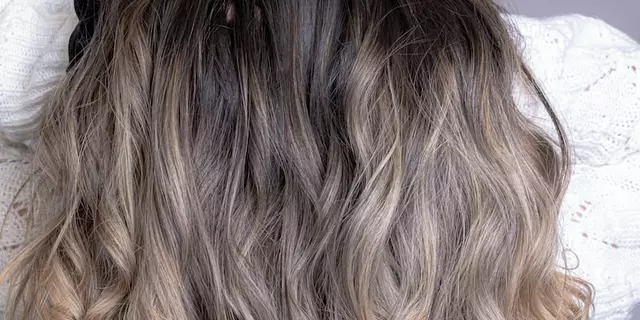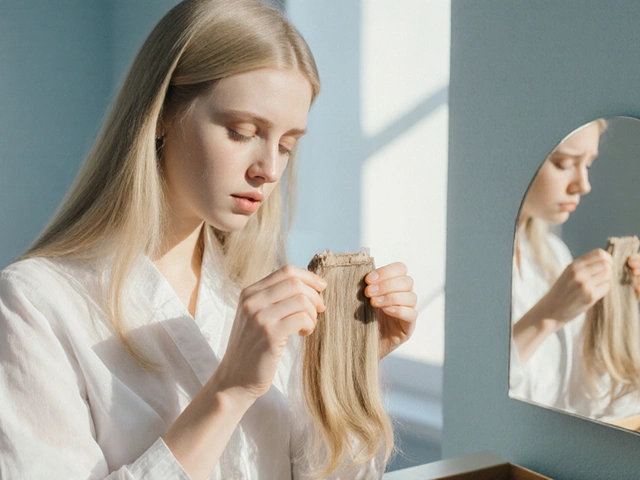When you first dye your hair, it’s easy to think the color will fade away over time and your natural shade will just... come back. Like magic. But here’s the truth: dyed hair doesn’t revert to its natural color. Not even a little. Once the dye is in, it’s stuck-until that strand grows out or gets cut off.
Human hair is dead. Once it pushes out of your scalp, it’s just protein-keratin-with no living cells, no blood supply, no ability to regenerate pigment. That means the dye molecules you’ve pushed into the cortex? They’re there to stay. No shampoo, no conditioner, no home remedy will pull them out and restore your original color. The only way to get back to your natural look is to wait for new hair to grow in-and that takes time.
How Long Does It Actually Take to Grow Out Dyed Hair?
On average, hair grows about 0.44 inches per month. That’s roughly half an inch every four weeks. If you’ve got dark roots growing in under bright platinum blonde, you’ll see that line clearly after just six weeks. But how long until you’re fully back to natural? It depends on your starting length and how far you’ve gone from your base color.
For someone with shoulder-length hair who dyed it a vibrant red, it could take 14 to 18 months to grow out completely. If you’re going from jet black to your natural light brown, and you’re keeping your hair long, you might be looking at 20 to 24 months. That’s not a typo. Two years. It’s not about the dye fading-it’s about the new growth replacing the old.
And here’s the kicker: the darker the dye, the longer it lasts. Permanent dye penetrates deep into the hair shaft and bonds chemically. Semi-permanent? It just sits on the surface. That’s why semi-permanent color washes out after 4 to 12 shampoos-but it also means it doesn’t cover gray as well or last as long. If you’re trying to transition from a bright color like blue or purple, you might see it fade faster, but your natural color underneath won’t change. You’re still waiting for new growth.
The Three Ways People Transition (And Which One Works Best)
There are three main paths people take when they want to return to their natural hair color. Each has pros, cons, and a very different emotional journey.
- The Gradual Grow-Out - This is the most common approach. You stop dyeing and let your roots grow. Simple, right? But without help, you end up with a harsh line-often called the “halo effect”-that looks like a bad ombre. It’s especially noticeable if your natural color is significantly lighter or darker than your dyed hair. About 41% of people try this method, but only about half are happy with the result by month six.
- The Big Chop - Cut it all off. Done. No more dyed hair. This works if you’re ready to go short and you don’t mind the shock of losing length. About 18% of people choose this route. The upside? Instant freedom. The downside? Most people aren’t emotionally prepared for how hard it is to adjust to short hair, especially if they’ve had long hair for years. A 2023 survey found 78% of people who did the big chop struggled with self-image in the first three months.
- Professional Blending - This is the method most salon professionals recommend. A colorist uses lowlights, highlights, or toners to blend your growing roots with the dyed hair, creating a seamless gradient. It doesn’t speed up growth, but it makes the transition look intentional, not messy. About 33% of people use this technique, and 89% of stylists say it’s the most effective way to manage high-contrast transitions.
Blending isn’t just about color. It’s about texture, porosity, and how your hair reacts to light. A good colorist will measure your percentage of natural gray or white hair using tools like the Hairprint System. If you’re 60% gray, your blending strategy is totally different than if you’re 30%. That’s why DIY tutorials often fail-everyone’s hair is different.
What Not to Do During Transition
One of the biggest mistakes people make? Trying to strip the color out. Bleach, color removers, or “clarifying” shampoos might seem like shortcuts, but they’re damage bombs.
Every time you bleach or chemically strip your hair, you’re breaking down its structure. Dyed hair is already weakened. Add another chemical process, and you’re asking for breakage, frizz, and split ends. One client on NaturallyCurly.com tried two rounds of bleach to “help” her transition from dark brown to natural. She ended up cutting off 12 inches of damaged hair-and her transition took 22 months instead of the expected 14.
Another common error: coloring too often. Some people feel pressured to touch up roots every four weeks, thinking it keeps things looking neat. But each time you apply dye, you’re adding more chemicals to hair that’s already stressed. Over-processing is the #1 reason for avoidable damage during transition, according to the International Association of Color Cosmetologists.
And don’t fall for viral TikTok trends that show someone going from neon pink to natural blonde in three months. Those videos are edited. They use wigs, lighting tricks, or post-transition photos. The average transition takes over a year. Setting unrealistic expectations leads to frustration-and worse, bad decisions.

How to Protect Your Hair While You Wait
Transitioning isn’t just about patience. It’s about care. Your hair is under more stress than ever-new growth, old dye, possible heat styling, and maybe even sun exposure.
Here’s what actually helps:
- Bond-building treatments - Products like Olaplex or K18 repair broken bonds inside the hair shaft. A 2024 clinical study showed clients who used these every 10 days maintained 41% higher tensile strength during transition.
- Deep conditioning - Use a moisturizing mask once a week. Look for ingredients like shea butter, ceramides, or argan oil. Avoid protein-heavy masks if your hair feels stiff or brittle-they can make things worse.
- Heat protection - If you blow-dry or straighten, always use a thermal protectant. Heat opens the cuticle and speeds up color fading, which can make blending harder.
- Regular trims - Every 12 to 16 weeks, get 1 to 2 inches cut off. It removes the oldest, most damaged ends and keeps your style looking fresh. Clients at Adhara Salon in NYC found this reduced the perceived length of their transition by 38%.
And yes-sunscreen for your hair exists. UV rays fade color and dry out strands. A hat or a leave-in product with SPF (like Moroccanoil’s UV Protect Spray) helps.
Why This Trend Is Growing-And What It Means
The movement toward natural hair isn’t just a phase. It’s a cultural shift. Since 2020, demand for transition services has jumped 220%. The global market for natural hair care is now worth $3.8 billion-and it’s expected to hit $6.2 billion by 2029.
Women between 35 and 54 make up 68% of those transitioning, and nearly half are choosing to embrace their gray hair. Social media plays a huge role. TikTok’s #growoutjourney has over 2.1 billion views. But here’s the problem: 61% of those videos show unrealistic timelines. People think they’ll be done in six months. They’re not.
Salons are responding. Many now offer “Natural Color Transition Specialist” certifications. In North America alone, 147 stylists are officially trained to guide clients through this process. And new tech is emerging-like AI color-matching apps and pH-balanced shampoos designed to gently release dye over time.
The bottom line? Transitioning to your natural color isn’t about going back. It’s about moving forward-with your hair healthier, your expectations real, and your choices informed.

Frequently Asked Questions
Can I speed up the process of dyed hair growing out?
No, you can’t speed up hair growth. Hair grows at a biological rate-about half an inch per month. No product, supplement, or treatment can change that. What you can do is manage the look of your transition with professional blending, strategic cuts, and proper hair care to avoid breakage.
Will my natural hair color look the same as before I dyed it?
Not always. If you’ve been dyeing your hair for years, your natural color may have changed. Gray or white hair can become more visible with age, especially after 35. Also, if you’ve bleached your hair multiple times, your natural pigment may be lighter than you remember. A professional colorist can assess your true base color using tools like the Hairprint System.
Is it better to grow out dye or cut it all off?
It depends on your goals and emotional readiness. If you’re okay with short hair and want a clean break, the big chop works. If you want to keep your length and avoid shock, gradual grow-out with blending is safer and more sustainable. Most people who try the big chop later regret losing their length, especially if they’re not prepared for the adjustment period.
Can I use semi-permanent dye to blend my roots?
Yes, and many people do. Semi-permanent color doesn’t damage hair like permanent dye or bleach. It fades gradually and can help mask roots between salon visits. But it’s temporary-you’ll need to reapply every 4 to 6 weeks. It’s a good tool for blending, but not a replacement for professional color work if you have high contrast between dyed and natural hair.
How do I know if I need a professional colorist for my transition?
If your natural color is more than two shades lighter or darker than your dyed hair, you need a pro. Also, if you’re unsure about your gray percentage, have curly or textured hair, or have damaged hair from past coloring, don’t try to DIY it. A certified Natural Color Transition Specialist can prevent damage, save you time, and make the process look intentional-not messy.
What Comes Next?
If you’re in the middle of a transition, you’re not alone. The average person spends 14.7 months getting back to their natural color. That’s more than a year of patience, care, and small wins. Celebrate the new growth. Take photos every month. Notice how your hair changes texture, how the light hits it differently. This isn’t just about color-it’s about reclaiming your identity.
And if you’re thinking about dyeing your hair again? Pause. Ask yourself: Do I want to go back to natural? Or am I just tired of maintenance? The answer changes everything.







mark nine
November 6, 2025 AT 07:49Tony Smith
November 6, 2025 AT 09:01Rakesh Kumar
November 6, 2025 AT 12:34Bill Castanier
November 7, 2025 AT 12:25Ronnie Kaye
November 9, 2025 AT 01:58Priyank Panchal
November 9, 2025 AT 19:25Ian Maggs
November 10, 2025 AT 05:26Michael Gradwell
November 10, 2025 AT 13:39